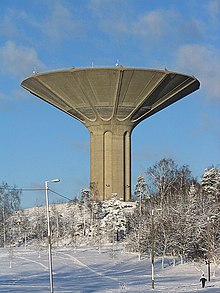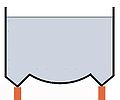Water tower
Water tower is the name of an operating structure in the water supply, a high-level tank for storage of drinking water or industrial water has. With the elevated tank, a temporary sufficient amount of water is kept ready, as well as sufficient and even pressure in the connected water network .
Working principle
The buildings connected to the water network are supplied with water solely with the help of the hydrostatic pressure resulting from the force of gravity . The elevated tank also serves as a compensation tank . The water taken from the water network leads to a reduction in the amount of water in the elevated tank. The elevated tank is therefore regularly refilled so that the water level remains at the same level as possible. In this way, the water pressure in the network is kept constant. In water networks with elevated tanks, pumps are only required to fill the elevated tank.
For sufficient pressure, all consumers must be lower than the elevated tank (principle of communicating pipes ). Tapping points that are higher up (e.g. high-rise buildings) require their own pressure boosting system.
Pros and cons, alternatives
Benefits include:
- Hydraulically, water towers have a simple structure. Due to their design, they compensate for pressure fluctuations on the inlet side and fluctuations in withdrawal on the outlet side. This results in low demands on the filling or the filling pump.
- Even without an energy supply, they can give off a certain amount of water. Reliability is z. B. important for drinking water hygiene.
- They also serve as symbols and advertising media.
The disadvantage is:
- The construction of a water tower is complex.
- The quality of the water in the container, which has not been replaced for a long time, can be impaired.
The storage function of water towers can be replaced by near-earth water storage . The required pressure can also be generated with regulated pumps in pressure boosting systems in the water distribution system, but with a higher technical effort.
Dimensions
The Schanzenturm in Hamburg, at its time one of the largest water towers in Europe, had a capacity of 4,600 m³. The Herten water towers with a capacity of 9000 cubic meters are among the largest elevated tanks of their kind in Germany.
One of the world's largest water towers today is the water tower in Roihuvuori near Helsinki, completed in 1977, with a capacity of 12,600 m³.
The Grand Central Water Tower Midrand in South Africa is an outstanding feature among the water towers , both in terms of its construction in the form of an upturned, 40 meter high cone and of the volume of 6,500 m³.
Construction / types
Water towers differ both in terms of their containers and their external appearance. There are massive towers (made of brick or concrete); In the industrial sector, however, mainly steel skeleton constructions were used. There are also wooden water towers.
The aqua globe is its own form of construction . This type of metal water tower was developed in Hungary in the late 1960s . It is a spherical water container on a column-like stand. This design was often used in the GDR .
Since a filled container causes a high compressive stress in the supports, the prevention of buckling must be given particular attention when dimensioning water towers . Since the risk of buckling is greatest for the axis with the lowest geometrical moment of inertia , water towers usually have symmetrical, in particular round, floor plans.
- Container shapes
Rectangular container
The first water towers (from 1830) had rectangular water tanks with flat bottoms. Internal tie rods had to be used to reinforce the walls , which were susceptible to corrosion and made cleaning of the container difficult. Later, the containers were made round so that only the still flat floor had to be additionally supported by a layer of beams. This design was almost exclusively integrated into buildings.
Loft container
A constructive improvement arose in France from 1860 onwards. The so-called loft containers had a dished bottom , the connection of which with the round container wall acted as a pressure ring. However, the expansion of the pressure ring repeatedly led to damage to the connecting structures. The external distinguishing feature of this design is a water tank that only slightly protrudes from the stand component.
Intze container
The problem of the expansion of the pressure ring was solved by the engineer Otto Intze in 1883 with a construction that became known as the Intze principle . The pressure ring is placed further under the container and the bottom is composed of an outer truncated cone and an inner dished bottom. In this way, all forces acting horizontally are balanced and cannot pass on any harmful tensions. A special design were the chimney containers , which were built in a ring around existing or newly built industrial chimneys from 1885, e.g. B. at the water tower in Dahlhausen . The first Intze tank was built in Remscheid in 1883.
Barkhausen container
With the so-called Barkhausen container (spherical bottom container) Georg Barkhausen developed a container with a hemispherical container bottom in 1898. The constant transition between the wall and the floor makes the support ring superfluous. The Barkhausen containers were built by the Dortmund company Aug. Klönne . The water tower of the Minister Stein colliery was the first container of this type to be built in 1899 . The water tower at Darmstadt Central Station was built according to this construction principle . Another example is the so-called Lanstroper Egg, completed in 1905, in the northeast of the city of Dortmund .
Klönne container
In 1898 August Klönne received a patent for a spherical container with a conical support. From 1906, water tanks of the Klönne type were mainly built. The supports acting on the circumference of the spherical container are usually connected tangentially to the container wall, as in the case of the Barkhausen containers.
history
Drinking water supply
In the 15th century, the city of Augsburg was a pioneer in the use of water art to supply drinking water . The oldest water tower in Germany is the Great Water Tower , built in 1416 at the waterworks at the Red Gate in Augsburg, the oldest waterworks in Germany and probably also in Central Europe.
In the second half of the 19th century, large numbers of water towers were built in Germany in order to guarantee the public supply of clean drinking water in the early days of the city , when there was increasing urbanization. The waterworks with large reservoirs and elevated tanks built during this period, in conjunction with supply and sewage pipes, made a significant contribution to preventing epidemics . Without the supply of the industrial cities with their often very cramped populations and large amounts of wastewater generating plants, epidemics of large proportions have repeatedly occurred.
Railway water towers
Water towers also served to keep a sufficient delivery volume ready for the water tanks of steam locomotives in the event of sudden large withdrawals . Starting with the development of the railway network , in Germany from 1840, the first elevated water tanks were built. These were not yet independent tower structures, but rather integrated as storage containers in station buildings, such as the Büchen railway water tower or, more recently, the water tower in the Dortmund depot . Later there were railway water towers designed as towers such as B. the one at the Hamburg-Altona depot . The typical capacity of larger railway water towers is around 400 m³, with which around ten tenders from large locomotives could be refueled without having to refill the tower container. In the Polish Iława (German Eylau) are three railway water towers that were built in the years 1871, 1915 and 1942nd
Extinguishing water storage
Water towers as extinguishing water reservoirs have the advantage that the water is already under pressure without the use of pumps and such systems also work in the event of a power failure.
Usage today
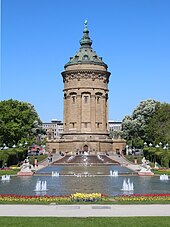
In high-tech infrastructures such as in Central Europe, water towers are currently only built in rare cases and existing systems are relieved of the tasks of water supply, wherever possible. The reason for this lies on the one hand in the three to five times higher investment costs and on the other hand technical specifications and qualitative requirements for the drinking water must be observed during operation, which can lead to higher operating costs compared to underground tanks.
Water towers are more common in the United States . In large cities as a container on high-rise buildings and free-standing on land. They are often painted or at least bear the name of the city. In France, too, water towers are more common than in Germany, for example, especially in rural areas. In areas remote from the infrastructure such as B. in rural areas of Senegal , a water tower can be filled with a pump and diesel generator, which would be less suitable for continuous operation.
Military point of attack
On the grounds that water towers could also serve as “target reference points” for terrorists or as prominent points in the landscape that enable weapons such as guns to be targeted. B. Mortars are used, water towers in Iraq were destroyed by the US Army. In northern Syria, IS destroyed hundreds of water towers before it withdrew.
Conversion and further use of water towers


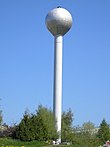


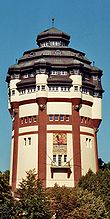


Today many of the still preserved water towers are structural and technical monuments.
An alternative to demolishing old water towers in need of renovation is their conversion . The technical installations (storage basins and pump systems) are often lost as a result, but this is how the shell can be preserved. The Danish Jægersborg Vandtårn , which was rebuilt in 2006, is noteworthy .
Another possibility is to use water towers in other ways beyond their actual function (additional use).
Some water towers are used as a lookout tower. There are also water towers with a tower restaurant , such as the Goldberg Tower in Sindelfingen or the Windrose in Viersen . As a rule, in the case of water towers with a viewing platform, visitors take an elevator to the viewing platform.
The use of both active and decommissioned water towers is also widespread as the location of transmission equipment in the VHF range with low power, such as for non-public land radio services and mobile radio . The converted Heidelberg television tower originally served as a water tower. Today it serves as the basic network transmitter of the SWR for FM and TV. The water tower in Waldenburg was also used as a transmission tower until 2009. The Wolfersberg water tower in Vienna is exceptionally used for radio technology and is used both for radio services in the VHF range and for a radio beacon in the long wave range.
The combination of water tower and chimney shows an original multiple use. The cylindrical water tank made of steel is typically about halfway up the chimney and surrounds it coaxially. The water tank usually has a flat conical roof and advertising text on the cylinder jacket. A certain flow of heat from the hot exhaust gas to the water can offer a side benefit if freezing is to be avoided.
Many water towers are converted into breeding grounds for birds and other animals by nature conservationists with little effort.
List of unused water towers
Germany, Austria, Switzerland
- Water tower at Berlin Ostkreuz train station
- Water tower in the Natur-Park Südgelände in Berlin
- Bruderholz water tower in Basel , Switzerland
- Water tower in Bremen-Blumenthal
- Tower of the Buléon church in Brittany, France
- Water tower at Darmstadt Central Station
- Water tower (Darmstadt repair shop)
- Water tower in Delmenhorst
- New Dessau water tower
- Deutzen water ball
- Bergheim water tower in Duisburg
- Water towers at Wedau marshalling yard
- Water tower in Eilenburg
- Water tower (Eppelheim) , landmark of the city of Eppelheim
- Water tower in Emden
- Water tower in Engers
- Water tower on the castle hill in Erlangen
- Water tower in Forst (Lausitz)
- Water tower in Freiberg , Chemnitzer Strasse
- Bismarck tower (Glauchau) and historical water tower of a former old people's home in the "district" Forsthaus (near Rothenbach)
- old water tower Gleina , 1906 in the historicist style of a medieval Wart tower built
- Goldberg Tower
- Water tower in Görlitz , Pomologische Gartenstrasse
- Water tower in Groitzsch
- Haberskirch water tower
- Water tower (Bahnbetriebswerk Hamburg-Altona) , one of the youngest water towers in Hamburg
- Hamburg-Rothenburgsort water tower
- Water towers on Hellweg in Hamm
- Water tower (Böckingen) , landmark in the Heilbronn district of Böckingen
- Herten water towers
- Water tower of the Ibbenbüren mine
- Water tower (Iosefin) , listed water tower in Timisoara
- Kehl water tower
- Water tower in box
- Town hall tower in Kornwestheim
- Water tower in Laupheim
- Water tower in Leer (East Frisia)
- Water tower in Leipzig - Probstheida
- Water tower Lübeck water art (1867)
- Water tower in Machtolsheim
- Water tower on Viersener Strasse in Mönchengladbach as well as water towers in Dahl and Wickrather Strasse (the former pump attendant's apartment in the first-mentioned water tower has been converted and is made available to artists as a studio for two years each time free of charge)
- Water tower in Mühlheim am Main
- Water tower in the Geistviertel in Münster
- Water tower in the north
- Water tower on Norderney , a listed building, built in 1929
- Offenbach am Main water tower
- Water tower Oldenburg-Donnerschwee , built in 1896
- Water tower in Plankstadt
- Water tower (Radebeul) , a technical monument
- Wasserturm (Rastatt) , water tower in Rastatt
- Water tower on the Lindenberg in Salzgitter-Thiede
- Sayda water tower
- Speyer water tower
- Water tower (1905) in the park of the Tannenfeld palace complex
- Biebrich water tower in Wiesbaden-Biebrich
- Water tower with pump wind turbine near Willegassen / Schönthal
- Water tower in Zerbst / Anhalt
- Water tower of Graz Central Station , listed in Graz-Lend, A
- Water tower Wiener Neustadt , landmark of the city, Lower Austria, A
- Wels water tower, Upper Austria, A
Other countries
- Water Tower (Gliwice) , Poland, a neo-Gothic building
List of converted water towers
Germany, Austria, Switzerland
- Water tower Belvedere in Aachen → Office space and restaurant
- Water tower in Alsdorf → CINETOWER Kinopark Alsdorf
- Water tower in Anklam → Apartment
- Water tower in Athensleben near Staßfurt → Lookout tower
- Water tower (Bad Doberan) → Apartments
- Water tower (Bad Soden) → Natural history exhibition
- Water tower in Bad Schwartau → Archive of the Schwartauer Werke
- Bardenberger water tower → private
- Bebra water tower → Museum
- Water tower at Obersee in Berlin-Alt-Hohenschönhausen → Wine bar / bar and apartment
- Water tower Tempelhofer Berg , Kreuzberg (Berlin) → Youth, culture and communication center
- Water tower Prenzlauer Berg , Berlin → Apartments
- Water tower in Berlin-Steglitz → Weather station of the Free University of Berlin
- Water tower in Berstadt → Folklore Museum
- Water tower in Bexbach → Museum
- Water tower of Bischofsheim → Architectural monument
- Water tower Bocholt → architectural monument, partly converted as a school building
- Borkum water tower → architectural monument, converted into a water museum
- Water tower on the Giersberg in Braunschweig → Architectural monument
- Blumenthal water tower in Bremen → Monument, day care center on the ground floor
- Vegesack water tower in Bremen → Architectural monument
- Water tower on the Werder in Bremen → “Lighthouse project” of a residential and office district
- Leher Wasserturm, Hafenstrasse , Bremerhaven → sold to Nordsee-Zeitung
- Leher water tower, Langener Landstrasse , Bremerhaven → privately owned
- Bremerhaven-Geestemünde water tower → Restaurant
- Residential water tower Bremerhaven-Wulsdorf
- Braunsdorf water tower (Niederwiesa) → Apartment
- Taurastein Tower Burgstädt → Lookout tower and gallery
- Crailsheim water tower as part of the former Crailsheim depot → restaurant
- Cuxhaven water tower with apartments and seminar room
- Water tower in Cuxhaven -Lüdingworth → Holiday apartment
- Water tower in Demmin → astronomy station with planetarium
- Old water tower in Dessau → State Main Archive Saxony-Anhalt
- Water tower of the Dortmund Südbahnhof → office space, shop, exhibition space
- Klotzsche water tower in Dresden → Apartments
- Water tower in Düren , district Merken → Apartments
- Water tower in Ebersbach-Neugersdorf → Apartments
- Water tower in Eberswalde - Finow → Architectural and industrial monument, brass works Finow observation tower
- Water tower Eichwalde → Apartment, office space
- Elmshorn water tower in Elmshorn → candle making and bistro
- Water tower (Eppelheim) → Wedding room and museum
- Water tower in Erkelenz → private residential tower
- Water tower in Essen-Bredeney → Apartments and offices
- Water tower in Essen-Steele → private gallery
- Frankfurt-Eschersheim water tower → assembly room
- Water towers in Fürstenwalde / Spree → Apartments and offices
- Water tower in Genthin lookout tower and tourist information
- Water tower in Gersthofen → Gersthofen balloon museum
- Water tower (Grimmen) → Ground floor city information, tower floor assembly room
- Groß-Gerau water tower → office space
- Water tower Groß Lafferde → Wedding room and museum
- Water tower Gütersloh → youth café / seminar rooms
- Municipal water tower Hagenow → Apartments
- Water tower Halle (Saale) main station → Advertising medium for the Bergzoo Halle (Saale)
- Water tower in Halle (Saale) North → technical monument, club rooms
- Water tower in Hamburg's city park → Planetarium
- Water tower Hamburg-Stellingen → Apartments
- Schanzenturm in Schanzenpark in Hamburg-Sternschanze → Hotel
- Water tower Hanover → Event and event center
- Water tower in Hanover-Misburg → rehearsal rooms
- Water tower Heide in Holstein → offices, registry office
- Hochfeld water tower in Duisburg → Restaurant
- Water tower in Hochheim am Main → Gastronomy
- Hohenbudberg water tower → private residential tower
- Hohenlockstedt water tower → Lookout tower and part of a museum
- Water tower Hohenschönhausen → bar, apartment
- Water tower in Husum → observation tower
- Water tower in Joachimsthal , State of Brandenburg → Biorama project
- Water tower in Kirchberg (Hunsrück) → is currently being converted for gastronomic use
- Water tower in Kirchmöser → Museum
- Water tower in Kempten (Allgäu) → is to be converted into an observation tower
- Water tower in Konstanz- Allmannsdorf, Otto-Moerike-Turm → Youth hostel
- Water tower in Konstanz , Stromeyersdorf → office space
- Ravensberg water tower in Kiel → Venue (theater, concerts, exhibitions etc.)
- Water tower Cologne → Hotel
- Langeoog water tower
- Water tower in Leinefelde → Town Hall
- Water tower in Lingen (Ems) → Architectural monument
- Water tower in Löderburg near Staßfurt → observation tower
- Water tower in Lüneburg → social center
- Salbker water tower in Magdeburg → artist workshop
- Water tower (Mannheim) → centrally erected as a symbol of progress
- Water tower in Meerbusch district: Lank-Latum → former celluloid factory
- Water tower (Mölln) → observation tower with various exhibitions
- Rheindahlen water tower in Mönchengladbach → Museum of Stone Age sites in the Lower Rhine
- Aquarius Water Museum in Mülheim an der Ruhr → Museum
- Water tower in Nauen → Apartment
- Water tower in Neunkirchen (Saar) → cultural center
- Water tower in Nienburg / Weser → Apartments
- Water tower in Nörvenich - Wissersheim → Single-family house
- Water tower in Oberhausen → offices and apartments
- Railway water tower Oldenburg harbor → office space
- Water tower in Pfalzfeld → Apartment
- Water tower Plön → Apartment
- Water tower at Potsdam Central Station → café, bistro
- Water tower in Prenzlau → A change of use is sought, 2004 Conservation of the facade by Stadtwerke Prenzlau
- Water tower in Rheinbach → artist's studio
- Rostock water tower → Youth meeting place and depot (collection of the cultural history museum)
- Schwetzingen water tower → Apartments
- Water tower in Seligenstadt → radio antennas
- Water tower in Siebenlehn → viewing platform in the elevated tank
- Water tower in Siegburg → commercial use by several companies
- Water tower in Solingen → light tower, laboratory and event location
- Water tower in Spremberg → Apartments
- Water tower in Strasburg (Uckermark) → Hotel and restaurant
- Water tower on the Petrisberg in Trier → observation tower
- Water tower at the Treffurt train station in Treffurt → Apartments
- Water tower in Uetersen → architectural monument
- Water tower in Uevekoven → Apartment and architecture office
- Water tower in Utscheid → Holiday apartment
- Water tower in Viersen (wind rose) → Restaurant
- Water tower in Visselhövede → Gallery and registry office.
- Water tower in Waren / Müritz → Apartments.
- Water tower (Walle) → Apartments
- Water tower Favoriten in Vienna → exhibition room, the container was used as a reverberation room for playing the saxophone
- Water tower (Worms) → Apartments
- Water tower paper factory Brigl & Bergmeister, Niklasdorf, Styria, A, from 1890
Other countries
- Water tower in Irkutsk , district Pervomajski → Club house and climbing wall of the cave exploration club
- Zabrze Water Tower , Poland → Apartments (planned)
More lists
- List of railway water towers in Germany
- List of water towers in Baden-Württemberg
- List of water towers in Berlin
- List of water towers in Hamburg
- List of water towers in Mannheim
- List of water towers in Schleswig-Holstein
- Water towers in the Düren district
Relevant standards / regulations
- Water Management Standards Committee [NAW] at DIN German Institute for Standardization eV (Ed.): Water supply - requirements for systems and components of water storage; German version EN 1508: 1998 . Beuth Verlag GmbH, Berlin, Vienna, Zurich 1998.
- DVGW e. V. (Hrsg.): Technical rule worksheet W 300, water storage - planning, construction, operation and maintenance of water tanks in the drinking water supply . Wirtschafts- und Verlagsgesellschaft Gas und Wasser mbH, 2005, ISSN 0176-3504 .
literature
- Thomas Wieckhorst: New use of water towers. Meininger Verlag, Neustadt an der Weinstrasse 1996, ISBN 3-87524-112-6 .
- Jan Werth: Causes and technical requirements for the development of elevated water tanks. In: Bernhard Becher , Hilla Becher : The architecture of the winding and water towers. Industrial architecture of the 19th century (= studies on the art of the 19th century. Volume 13). Prestel, Munich 1971, ISBN 3-7913-0323-6 , pp. 325-428 (Werth = also: Aachen, Techn. Hochsch., Diss., 1969).
Web links
- List of water towers
- Designs of elevated water tanks
- German international water tower society
- Water towers in the Ruhr area and the surrounding area
swell
- ↑ Russel C. Hibbeler: Technical Mechanics 2 Strength of Materials . 8th edition, Pearson Germany, Munich 2013, ISBN 978-3-86894-126-5 .
- ^ City of Augsburg. In: augsburg.de. Retrieved May 29, 2018 .
- ^ Martin Kluger: Hydraulic engineering and hydropower, drinking water and fountain art in Augsburg. 1st edition. Context Verlag, Augsburg 2013, ISBN 978-3-939645-72-6 , p. 2 .
- ↑ DVGW e. V .: Worksheet W 300, water storage - planning, construction, operation and maintenance of water tanks in the drinking water supply. DVGW German Association of the Gas and Water Industry e. V., Bonn 2004, paragraph 5.1.3.2.
- ^ How Water Towers Work (article), Marshall Brain, howstuffworks, accessed 2014.
- ↑ Help for Africa - Water for Senegal ( Memento from March 20, 2014 in the web archive archive.today ), section Water project Gouye - Ndiogou, Franz Bickel u. a., 2013, accessed 2014.
- ↑ Remote Kenyan High School Supplied with Water , Cory Drake, accessed 2014.
- ↑ globalsecurity.org Globale Sicherheit.org; APPENDIX H: RANGE CARDS AND SECTOR SKETCHES (English).
- ↑ LiveLeak.com Video - Destruction of a water tower in Mosul .
- ↑ Wolfgang Bauer: Northern Syria - The great fate . In: ZEITMagazin . Hamburg January 25, 2018 ( zeit.de ).
- ↑ The Edisefettraffinerie Estermann, today VFI GmbH, had such a chimney from 1912 to at least 1970 in Wels , Upper Austria, at the former location on the railway north of Baumgartnerstrasse. The Company> Milestones vfi.co.at, accessed January 29, 2020.
- ↑ A hotbed of the water tower. ( Memento from January 2, 2011 in the Internet Archive )
- ↑ Convert the transformer house or water tower into an animal hotel .
- ^ Watertoorn Börkum. Watertoorn Börkum eV, accessed on March 14, 2016 .
- ↑ Homepage of the operator of the Stromeyersdorf water tower
- ↑ St | LN | Brigl & Bergmeister AG, Niklasdorf schlotforum.files.wordpress.com, accessed January 29, 2020.
- ↑ History brigl-bergmeister.com, accessed January 29, 2020.






